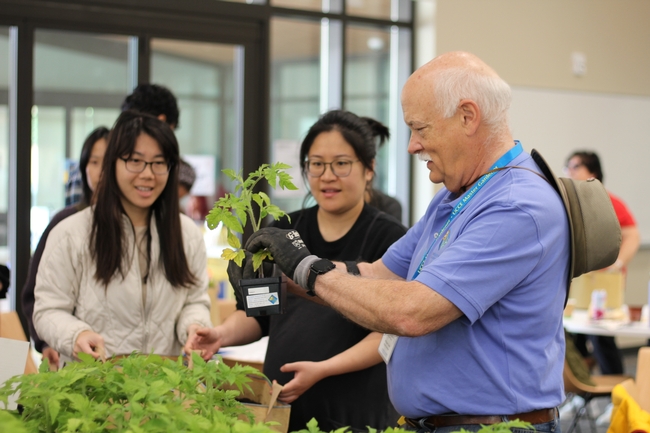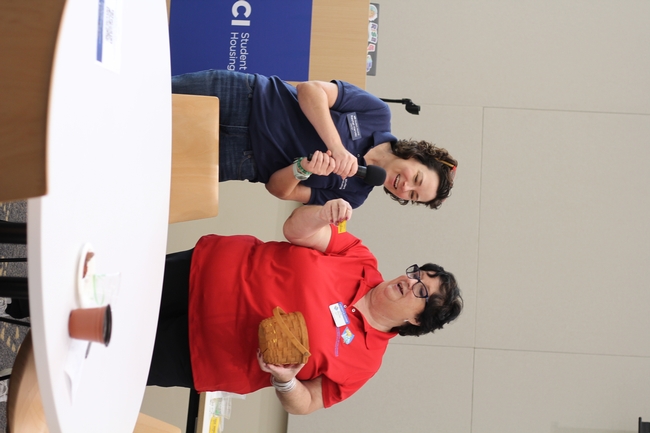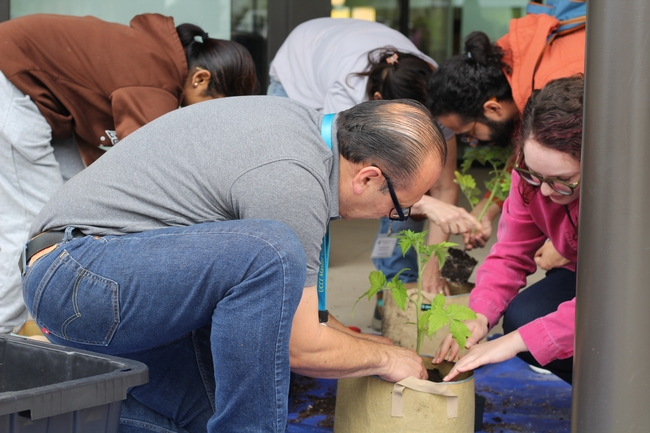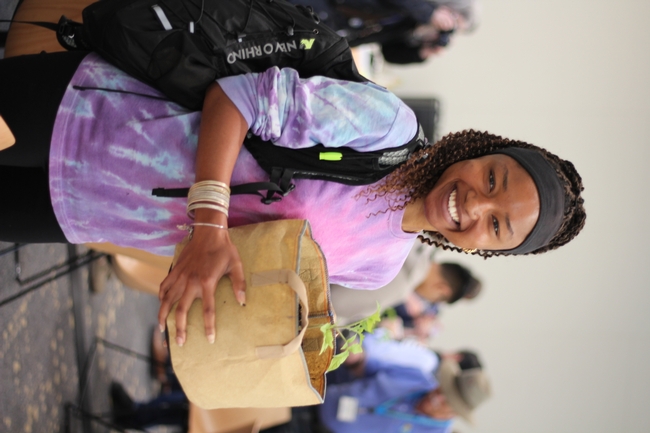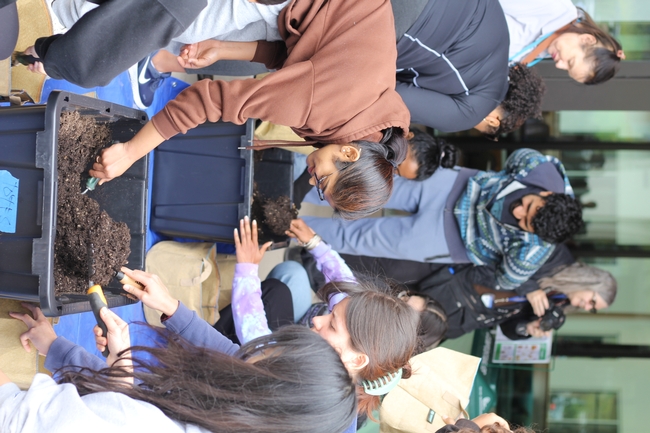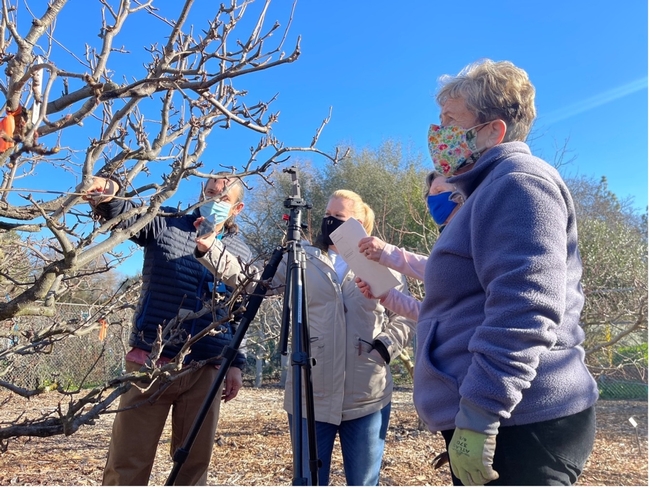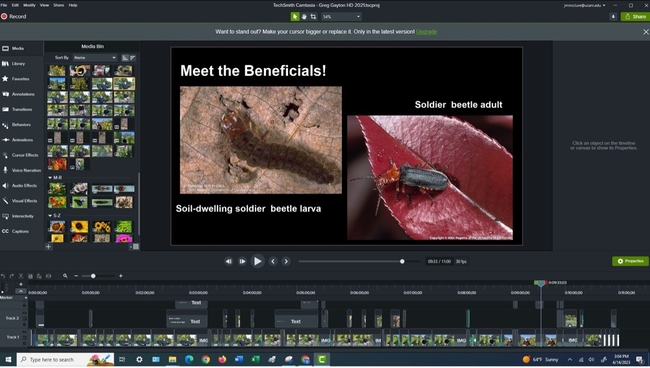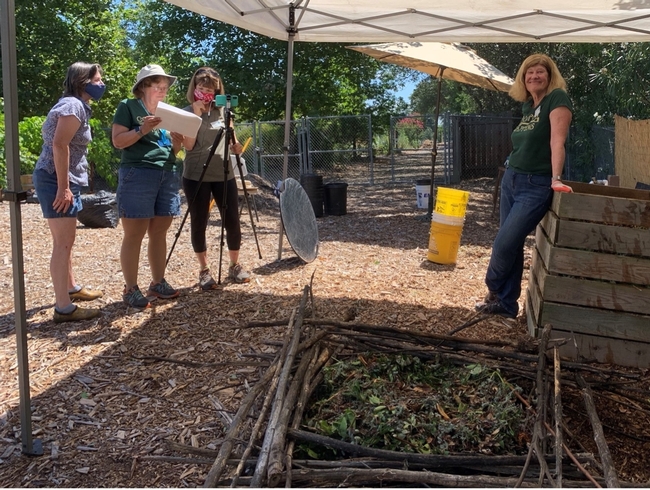- Author: Saoimanu Sope
Although training is required to become a University of California Master Gardener, the benefits of gardening can be experienced by anyone and everyone.
“As long as you're willing to get your hands dirty,” said Laurie Menosky, a UC Master Gardener volunteer in Orange County, “you can learn to grow all sorts of things.”
In early April, Menosky partnered with ETN Medical Infusion (a clinic in Orange County) and the Sustainability Program for Student Housing at UC Irvine to teach students how to grow tomatoes. Menosky welcomed all in attendance, including families with toddlers who seemed fascinated by the 60 tomato plants atop one of the tables in the room.
The UC Master Gardener Program is a part of UC Agriculture and Natural Resources. During her presentation, Menosky taught participants how to choose varieties that fit their taste and growing environment, how to cultivate a thriving environment, and how to control pests and diseases using integrated pest management practices.
“We have 16,000 residents at UCI and sustainability is one of our values. One of the ways we engage students is through on-campus gardens,” said Rachel Harvey, sustainability program manager for UCI Student Housing and a UC Master Gardener volunteer in Orange County.
UC Irvine has one teaching garden reserved for undergraduate learning, and three gardens operated and maintained by graduate students. “I was on the waiting list for a garden plot for a while, but it was totally worth the wait,” said Johanna Rinaman, a fifth-year Ph.D. student studying physical chemistry.
While the highlight of the event for many people was the opportunity to take a tomato plant home, another important takeaway was how gardening can be a good activity for your mental health. Sarah Nghiem, family medicine specialist at ETN Medical Infusion, who worked closely with Menosky, was instrumental in developing the mental health content for the day, encouraging attendees to attempt gardening with a mental health perspective.
Nghiem and her team received funding from the Orange County Health Care Agency through the Mental Health Services Act to work with transitional aged students (15-24 years-old) on understanding the importance of mental health, which led to the collaboration between UC Irvine, her alma mater, and the UC Master Gardeners of Orange County.
“I didn't do any gardening during the winter, and I felt a lot more anxious and depressed during that time,” Rinaman said. “I know gardening improves mental health because I've immediately felt a difference whenever I spend time with plants.”
Rinaman, whose father taught her a lot of what she knows about gardening, said that having access to a 4 feet by 6 feet plot to grow her own food is one of the many things she loves about UC Irvine.
Like Rinaman, Menosky turns to gardening to decompress, especially during the long days of summer. Teaching others about the physical and mental benefits of gardening gives her an opportunity to share her experience and, hopefully, help others find new ways to manage stress.
“We often have attendees come back years later telling us how our information has helped them and how much more they are enjoying their time in their gardens,” she said.
To conclude her presentation, Menosky instructed participants to line up for their own tomato plant. Attendees took their plants outside to transfer them from a small pot to a grow bag – a type of container that helps root structure development.
Cassie Ekwego, a third-year transfer student studying civil engineering, couldn't hide her excitement after carefully lifting her plant. “I don't think I realized how attentive you need to be when working with plants,” said Ekwego, reflecting on what she learned from Menosky's presentation.
Now that she has her own plant to care for in her own home, Ekwego is eager to put her new knowledge to the test. “I love tomatoes, but this is going to be a huge responsibility for me,” she said.
Randy Musser, UC Master Gardener program coordinator for Orange County, said that while he enjoys talking to avid gardeners, bringing gardening to new people in the community is special to him. “This tomato workshop is particularly exciting for me because it is an opportunity for the UC Master Gardeners to grow our connection to UCI and young people just starting off on their gardening journey,” said Musser.
With a generous contribution from UC Master Gardener volunteer Sheila Peterson, Musser was able to purchase enough supplies to help attendees, like Ekwego, jumpstart their gardening experience.
Students, whose stress levels can skyrocket throughout the school year, value opportunities to be outdoors, try something new and be in community. “The garden is a different type of classroom. It's a place where students can learn and experiment, hopefully in a way that reduces stress,” said Harvey of UCI Student Housing.
Ekwego, who tried gardening for the first time while volunteering at UC Irvine's teaching garden, is just one of the many students inspired by their experiences. “Gardening reminds me that it's OK to get my hands dirty,” Ekwego said.
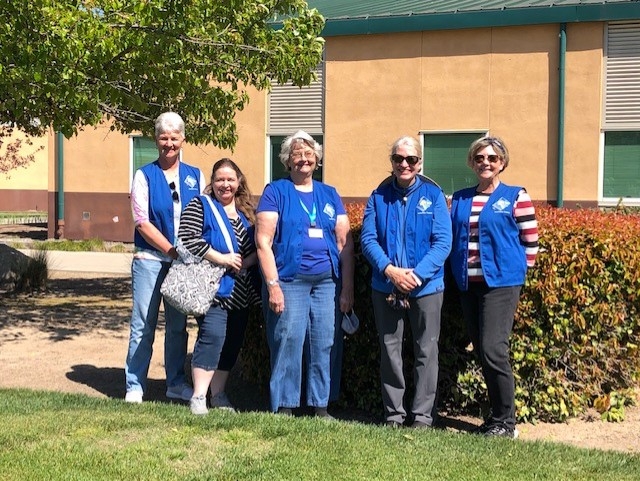
It's #Giving Tuesday! Have you gained knowledge as a result from meeting our UC Cooperative Extension Master Gardeners at a library class, outdoor event, or while visiting one of gardens? If so, we hope you will consider making a donation to our program.
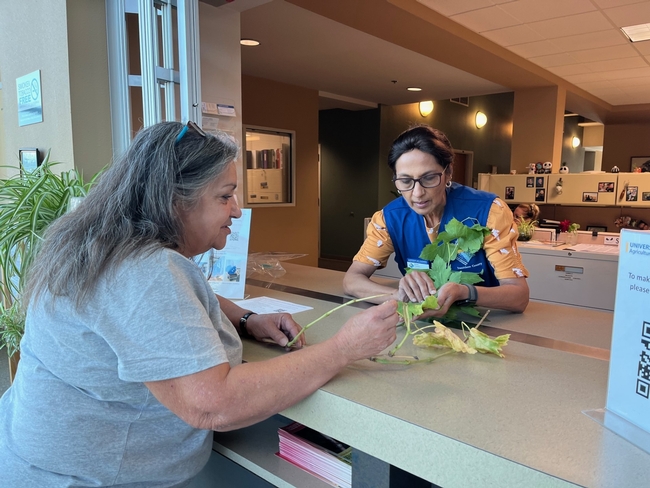
Every dollar counts! Your support makes our mission of promoting gardening education in our community possible! Visit https://donate.ucanr.edu/givingtuesday/ and select UCCE Stanislaus County Master Gardeners from the drop down window to give today, on #GivingTuesday.
Thank you for considering us when making your year-end, tax deductible donation. (We are a 501 c(3)).

- Author: Janet Hartin
Welcome to Fall!
It's my favorite season and likely for many of you, as well. Beyond the holidays and extra time with family and friends, nature radiates its beautiful hues. In addition to lovely foliage, deciduous trees often expose exquisitely shaped and sturdy trunks. And, of course, there is the lovely fall foliage showcased by many species.
Did you ever wonder why trees "turn" color in the fall? The short answer: It's primarily a function of long, cool fall nights and short, sunny days. The longer answer? Chlorophyll is responsible for the basic green color of leaves we see in spring and summer and is a necessary component of photosynthesis, which uses sunlight to manufacture sugar (food) that is stored during the dormant period of the year. Carotenoids produce yellow, orange and even brown pigments in crops such as carrots, squash, bananas and many ornamental plants such as daffodils and poppies. Anthocyanins are red and orange in color and are most linked to lavish displays of brilliant fall foliage. They also give rise to coloring of strawberries, plums and cherries.
Here's the kicker: While chlorophyll and carotenoids are present in leaf cell chloroplasts throughout the entire growing season, during fall chlorophyll begins to break down. Voila! The lovely yellow and orange hues we all look forward to seeing are finally exposed. In addition, red hues (called anthocyanins) are produced in fall. So, in reality foliage doesn't "turn" orange or red at all.
Interestingly, the actual timing of color change varies across species and appears to be genetically inherited. The same species will exhibit a similar color scheme in cool temperatures in higher elevations at nearly the same time as it does in warmer lower elevation climates.
The intensity of color can vary quite a bit however. Where do temperatures enter the picture? Both the amount of color and the overall intensity of fall color is very linked to weather conditions that occur prior to and during the actual time the chlorophyll in leaves winds down. The most brilliant displays occur after several warm, sunny days and cool, crisp (above freezing) nights. This is because although lots of sugars are made in leaves during sunny daytime hours, the corresponding cool nights prevent the sugars from moving out. The amount of soil moisture also helps ensure that from year to year fall colors vary even in the same trees. So, either a late spring or a prolonged drought can both delay the display of fall color by a few days or even a few weeks.
What's the recipe for the most brilliant fall display? Most likely a warm, moist spring followed by a warm summer and sunny fall with cool autumn nights. Although fall color is not nearly as spectacular in lower elevations of Southern California compared to other colder areas of the nation, the liquidambar or American sweet gum (Liquidambar styraciflua) offers some pretty impressive fall color and an impressive 300 to 400-year life span. (Did you know that liquidambar got its name because it at one time was a sought-after chewing gum for Native Americans?)
Two “climate-ready” tree species with lovely fall foliage that grow in both the west portion of the county and the desert are the ‘Keith Davey' Pistache, a large street and park tree sporting crimson to scarlet colored foliage and its relative, the ‘Red Push' Pistache, a hybrid between P. atlántica x P. integerrima) which has lovely red foliage as it emerges in Spring as well as Fall. Others include the Raywood Ash (Fraxinus oxycarpa 'Raywood') sporting a reddish-purple hue in the fall, and the ‘Sunburst' Locust (Gleditsia triacanthos var. inermis 'Sunburst') which offers a vivid display of fall color. Unfortunately, it is susceptible to the Invasive Shot-Hole Borer. If you have one of these lovely trees already, take good care of it to help it stand up to this aggressive pest!
Happy Fall! Enjoy the cooler weather, family and friends, and lovely trees!

- Author: Skylar Peters
- Author: Melissa Womack
In 2020 near California's state capital, UC Master Gardeners of Sacramento County awaited with excitement for its annual Harvest Day they organized each year. But the ongoing pandemic forced the cancellation of this much-anticipated event leaving the usual over 1500 attendees disappointed. Each year Harvest Day provided a colorful assortment of speakers, vendors, and food all in celebration of sustainable gardening. In the name of resilience, the UC Master Gardeners of Sacramento County charged a path of embracing change while cultivating accessibility to gardening help and the beloved tradition of Harvest Day.
With grit and determination, the UC Master Gardeners transformed Harvest Day into “Virtual Harvest Day,” an online learning experience that overcame the barriers that Covid created. An incredible video learning experience took the place of the in-person festival. Instead of Harvest Day's typical speeches and demonstrations, UC Master Gardeners created over 20 captivating videos debuting on its newly established YouTube channel.
“Virtual Harvest Day” was an extraordinary success attracting an audience of 4,389 viewers, nearly three times the normal average number of in-person attendees. This victory inspired the program to continue providing gardening support through online webinars and recorded videos. This innovative approach eliminated the many obstacles of the pandemic and welcomed gardeners from around the world. Now, plant lovers, garden enthusiasts and gardening beginners from all walks of life can access UC Master Gardener help.
Since the launch of the YouTube Channel, subscriber counts have skyrocketed to about 22,800 with an astounding increase of +4,500 since April and more than 200 views daily. The comments section showcases gratitude for the helpful content with comments like, “Very informative and helpful video! Thank you” and “I have learned mistakes made previously in my garden. Well done!!!”
The green thumb classroom enriched the lives of the UC Master Gardeners of Sacramento County themselves. Through the video creation process, UC Master Gardeners were able to dive deep into research, writing, and production allowing their gardening knowledge and ability to educate to blossom.
UC Master Gardener of Sacramento County's video project serves as an inspiration across the state and has inspired other programs to create accessible video content. The setbacks of the Covid pandemic demonstrated the UC Master Gardeners of Sacramento County's resilience and dedication to giving back to their community. Volunteers turned a pandemic cancellation into an educational experience that transcends the limitations of time and location and creates an online community space centered around gardening. The program's YouTube channel has opened the doors of gardening education to people who never had access before. Congratulations to UC Master Gardeners of Sacramento County for their dedication and perseverance that won them third place in the Search for Excellence awards competition!
- Author: Anne Schellman
Are you interested in helping others and giving back to your community? Do you have a passion for gardening and volunteering? The Stanislaus County* UC Master Gardener Program is accepting applications for 2024.
Who are the UC Master Gardeners?
Master Gardeners are volunteers from the community that are trained to help answer questions about gardening and pest management and to promote sustainable landscaping. Watch this short video from the Coordinator, Anne Schellman, about what it takes to be a Master Gardener.
How are UC Master Gardeners Trained?
Classes are taught by University of California experts on water management, soils and fertilizers, ornamental and drought tolerant plants, landscape tree care, vegetable and fruit tree care, pest management, and more. Each session is approximately 5 hours long. The 2024 training program will be held weekly from January through early May (18 weeks).
Program requirements include weekly reading and quizzes, and an open book a final exam. Collaboration on assignments is encouraged, and trainees are provided any needed assistance by Master Gardener mentors.
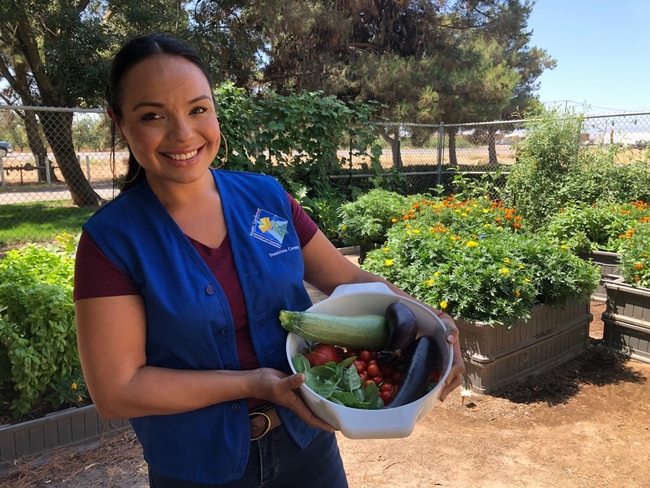
How Can I Apply to Become a UC Master Gardener Trainee?
Visit Become a UCCE Master Gardener website page to read more and fill out an online application before August 18.
*You must be a Stanislaus County resident to apply. For other county programs, visit http://mg.ucanr.edu/FindUs/

